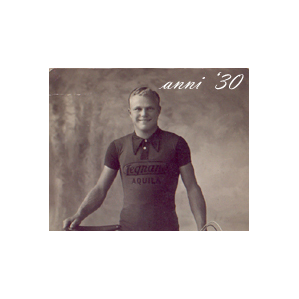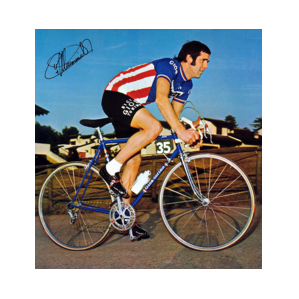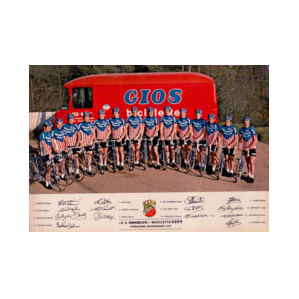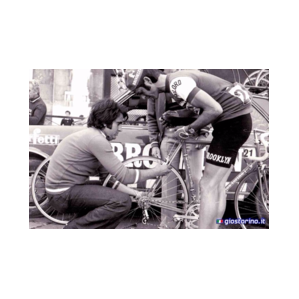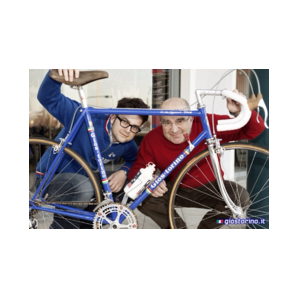Gios
Storia di Tolmino Gios

Nato nel 1916 a Vittorio Veneto, Tolmino Gios portava il nome d'una località, oggi in territorio sloveno, legata ai fatti d'arme della grande guerra. Non aveva ancora due anni quando la famiglia decise di emigrare a Torino, dove Tolmino scopre per la prima volta la bicicletta: Il successo più memorabile rimane la Coppa del Re a Milano, nel 1936. Un sondaggio dello "Sport Illustrato" lo dà come grande favorito ai mondiali del '36, a Berna, e soprattutto alle Olimpiadi di Berlino. Ma viene escluso dalla rosa dei titolari, pagando uno scontro d'opinioni con il commissario tecnico. Dopo il secondo conflitto mondiale, dove venne richiamato come bersagliere, nel '48 apre una piccola officina Nella primavera del '58 si presenta da lui :Italo Zilioli. Nel 1959 Alfredo Gios, primogenito di Tolmino, entra a far parte dell'affermata azienda torinese, che già all'epoca vantava un discreto mercato. Nel 1966 entra a far parte dell' azienda il terzo figlio di Tolmino, Aldo, Nel 1968 Tolmino affida tutto ciò che aveva sapientemente costruito dal nulla ai "Fratelli Gios": Alfredo e Aldo. Nonostante il passaggio delle consegne, Tolmino rimarrà ancora a lungo all'interno della Gios.
Caratteristico delle bici Gios è l'inconfondibile colore blu. Iconic and terrifically elegant! Negli ani settanta Gios sponsorizzò il team Brooklin dove un campione del calibro di Roger de Vlaeminick conquistò prestigiose vittorie.
Nel 1980 la Gios sviluppa una particolare testa della forcella, scavata nella parte superiore, per diminuire il peso. Nel 1983 introduce il forcellino Gios compact, primo forcellino regolabile e sostituibile.
Hanno corso con la Gios, Italo Zilioli (nella categoria allievi), R. De Vlaeminck, Patrick Sercu, Dietrich Thurau, Alfons De Wolf, Michel Pollentier, Hampsten, Roberto Visentini, Stephen Roche.
Il nome Gios è uno dei grandi pilastri della storia e della cultura del ciclismo italiano e il Gios Torino Super Record è un vero monumento del suo tempo.

Born in Vittorio Veneto in 1916, Tolmino Gios bore the name of a place, today in Slovenian territory, linked to the arms of the great war. He was not yet two years old when the family decided to emigrate to Turin, where Tolmin discovers the bicycle for the first time: The most memorable success remains the King's Cup in Milan, in 1936. A survey of "Illustrated Sport" gives him as great favorite at the 1936 World Cup, in Bern, and especially at the Berlin Olympics. But he is excluded from the list of holders, paying a clash of opinions with the technical commissioner. After the Second World War, where he was called up as a target, he opened a small workshop in 1948. In the spring of 1958 he introduced himself to him: Italo Zilioli. In 1959 Alfredo Gios, Tolmino's eldest son, joined the well-established Turin company, which already had a fair market at the time. In 1966 Tolmino's third son, Aldo, joined the company. In 1968 Tolmino entrusted everything he had wisely built from nothing to the "Gios Brothers": Alfredo and Aldo. Despite the handover, Tolmin will remain within the Gios for a long time. Characteristic of Gios bikes is the unmistakable blue color. Iconic and terrifically elegant! In the seventies Gios sponsored the Brooklin team where a champion of the caliber of Roger de Vlaeminick won prestigious victories. In 1980 Gios developed a particular fork head, dug in the upper part, to decrease weight. In 1983 he introduced the Gios compact dropout, the first adjustable and replaceable dropout. They ran with Gios, Italo Zilioli (in the students category), R. De Vlaeminck, Patrick Sercu, Dietrich Thurau, Alfons De Wolf, Michel Pollentier, Hampsten, Roberto Visentini, Stephen Roche. The Gios name is one of the great pillars in Italian cycling history and culture, and the Gios Torino Super Record is a true monument of its time.






